When Does Baby Cottonmouth Season Start?
#mobileSnakeQuizControls { overflow: hidden; text-overflow: ellipsis; white-space: nowrap; }
@media (min-width: 481px) {
.mobile-top-content {
display: none;
}
}
#mobileTopContentCTACarouselControls { overflow: hidden; text-overflow: ellipsis; white-space: nowrap; }
.mobile-top-content .more { color: #fff; }
.mobile-top-content a { color: #fff; text-decoration: underline; }
.mobile-top-content a:hover { color: #fff; text-decoration: underline; }
@media (max-width: 480px) {
.mobile-top-content {
background-color: #06a10b;
color: #fff;
text-align: center;
/*height: 60px;
padding-top:5px;*/
font-size:80%;
/* display: block; */
margin: 0px -30px;
}
}
Also known as a water moccasin, black mocassin, gaper, and swamp moccasin, the cottonmouth (Agkistrodon piscivorus) is a highly venomous pit viper species native to the southeastern United States. Cottonmouths often spend time near water, so you will likely find them in river floodplains, wetlands, bays, lakes, swamps, and other marshy areas. They are capable swimmers that can swim between barrier islands and the mainland.
Adult cottonmouths deliver a painful and potentially fatal bite when provoked. They usually stand their ground, gape at the intruder, and respond by coiling their bodies and displaying their fangs when threatened.
Adults are 2-6 feet long. Females are smaller than males. Females weigh between 7.09-8.96 oz (201.1-254.1 g), while males weigh around 10.32-20.44 oz (292.5-579.6 g). They vary from light brown to dark brown, with dark spots and speckles on their crossbands. They have bright white mouths and large spade-shaped heads.
button.pulse {
transform: scale(1); animation: pulse 2s infinite;
box-shadow: 0 0 0 0 rgba(11, 247, 25, 1);
}
@keyframes pulse {
0% { transform: scale(0.90); box-shadow: 0 0 0 0 rgba(11, 247, 25, 0.5); }
60% { transform: scale(1); box-shadow: 0 0 0 15px rgba(11, 247, 25, 0); }
100% { transform: scale(0.90); box-shadow: 0 0 0 0 rgba(11, 247, 25, 0); }
}
But what about baby cottonmouth? Baby cottonmouths have striking features that differentiate them from adults. This article will give you insights about baby cottonmouth season and how you can distinguish them from other water snakes.
When Do Baby Cottonmouths Start Appearing?
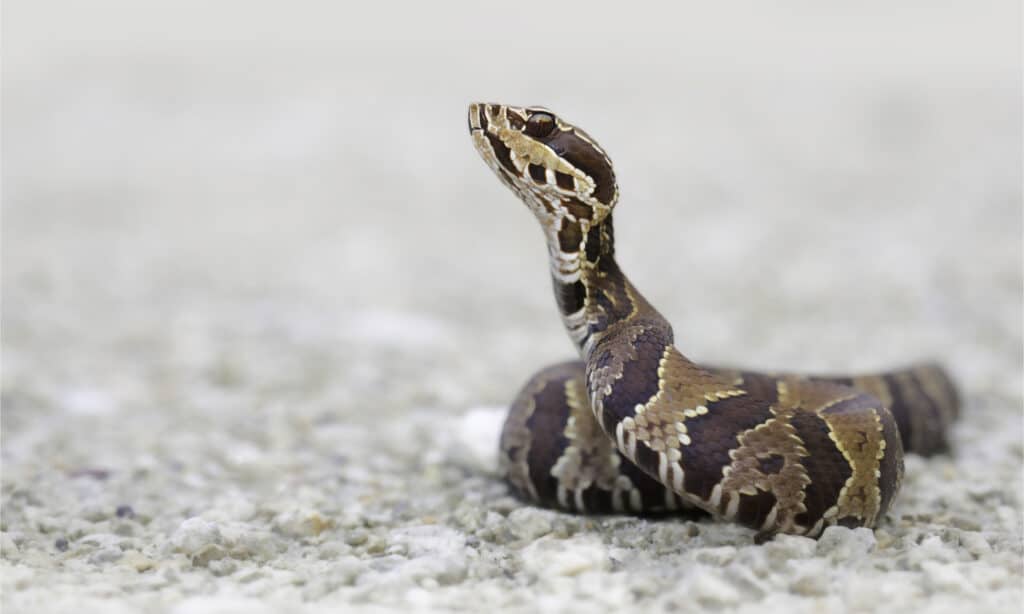
Kristian Bell/Shutterstock.com
Cottonmouths mate in spring, generally from April to May. During this time, males slither around, waving their tails to attract the females’ attention and lure them away from other male suitors.
The gestation period lasts five months, and females give birth to around 10-20 offspring every 2 to 3 years. Baby cottonmouths are born in late summer. They are typically about 8 inches (20 cm) long and are born brightly colored, which fades off as soon as they start going on their own. They weigh approximately 1.14 oz (32.5 g) at birth.
How to Identify a Baby Cottonmouth
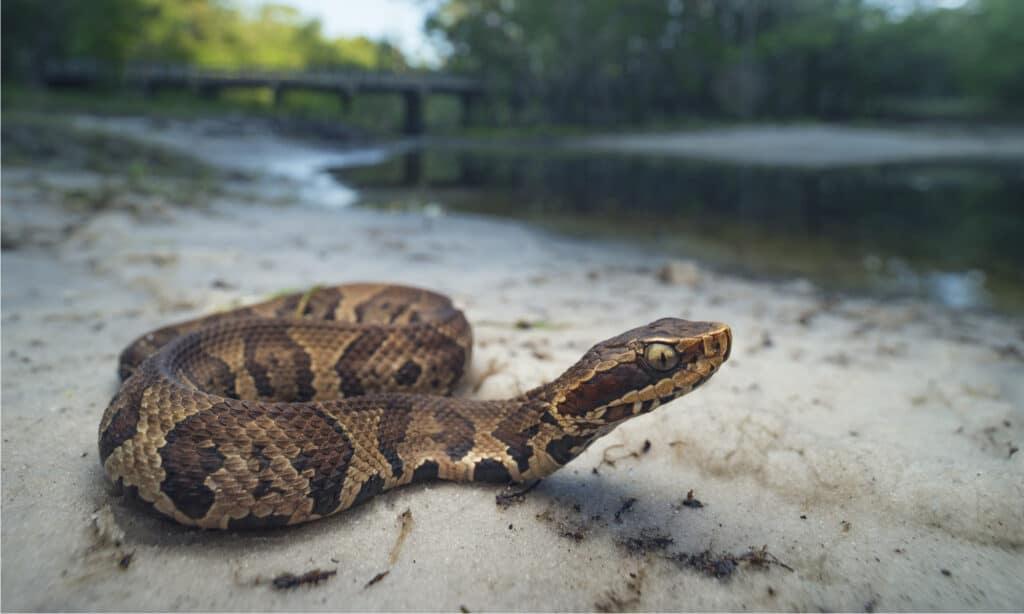
Kristian Bell/Shutterstock.com
Baby cottonmouths are often mistaken for other non-venomous water snakes. They have a distinctive green or yellowish tail. The tail changes from yellow to green hue as they head into adolescence, and eventually black. Black tails are a clear indication that they have reached adulthood.
Unlike the adult’s black color, baby cottonmouths are tan with around 10-25 reddish-brown bands that appear darker. The ridged or keeled scales at the back of these snakes make their bands more prominent. Their skin darkens as they age.
Baby cottonmouths have a light-creamed belly decorated with brown-yellow blotches, giving them a unique appearance. The young cottonmouth has two dark stripes by its nostrils. Their chins appear darker on the head. This is one way you can differentiate them from a baby copperhead snake.
Where Do you Find Baby Cottonmouths?
Like their parents, the young water moccasins enjoy living close to marshes, swamps, and ponds. They can also be found in streams and drainage ditches. You may catch a glimpse of a baby cottonmouth swimming with its head above the water surface. They hibernate during the winter in rotting stamps or burrows made by other animals, including turtles and crayfish.
What Do Baby Cottonmouths Eat?
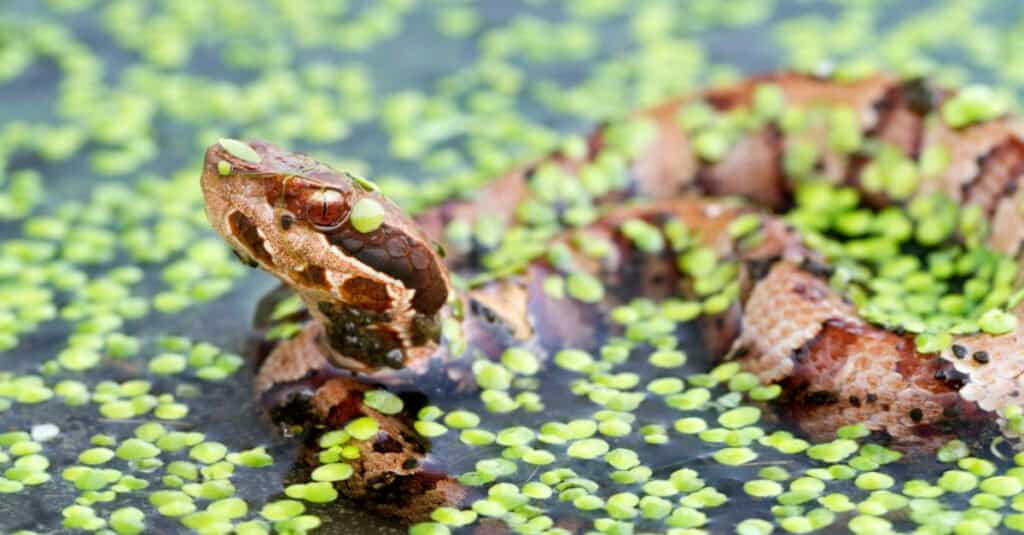
Mark_Kostich/Shutterstock.com
Their diet comes from the water they inhabit. The young water moccasins mainly eat lizards, fish, frogs, tiny turtles, and small snakes occasionally. They are predominantly carnivores. Baby cottonmouths are typically active early in the morning and late in the evening, especially in the summer.
They hunt prey in water or on land. Baby cottonmouths kill with a venomous bite, then wrap around their prey until it stops moving before swallowing. In turn, they are vulnerable to predation from animals like cats, eagles, raccoons, alligators, and snapping turtles, which is why many baby cottonmouths hardly make it to adulthood.
How Does the Diet of Baby Cottonmouths Impact the Ecosystem?
Baby cottonmouths maintain balance in the food web. Without them, the number of frogs, lizards, fish, and other prey would increase to unnatural levels and destroy the stability of the ecosystem. Similarly, if many baby cottonmouths are killed, eagles, alligators, and other predators that eat the young moccasins will struggle to find food.
Are Baby Cottonmouths Dangerous?
Baby cottonmouths are not more dangerous than adults. Like adults, they only bite when provoked. The young mocassin produces less venom, but its bite is excruciating and dangerous to humans. The poison causes immense swelling and tissue damage. The bite also contains extra bacterial infection since they sometimes feed on carrion.
What Happens When a Baby Cottonmouth Bites You?
Baby cottonmouths’ venom falls under the category of a hemotoxin, which affects the circulatory system by inhibiting blood clotting through the destruction of red blood cells. Humans bitten by the juveniles will feel an immediate burning pain. The wound then swells after a few minutes. Lack of immediate medical attention may lead to permanent tissue and muscle damage. The victim may even require amputation if left untreated.
What Snakes are Most Commonly Mistaken for Baby Cottonmouths?
Many baby cottonmouth look-alikes often get mistakenly killed. Here are some of the species to help you distinguish between the young moccasins and other non-venomous snakes.
1. Hognose Snake

iStock.com/chas53
Like the baby cottonmouths, hognose snakes have dark body colors and faint bands. They also exhibit color variations as they age. Hognose snakes flatten their heads and strike with closed mouths when threatened. As opposed to hognose snakes, the young moccasins attack while theatrically displaying the white interiors of their mouths. Both snakes also live in different habitats. Hognose snakes prefer a drier habitat, while baby cottonmouths live near water.
2. Western Mud Snake
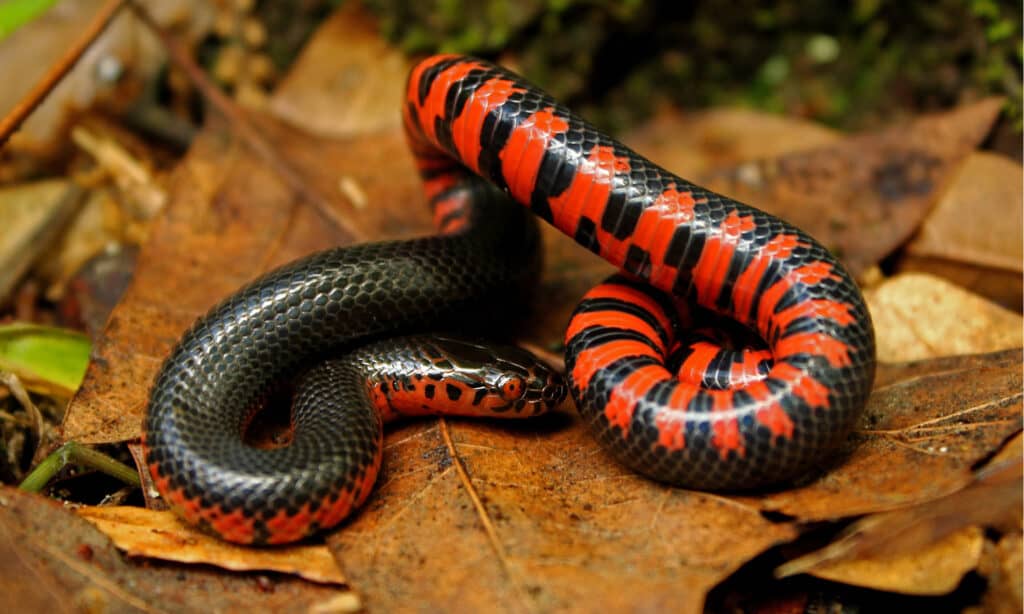
Thesigner_2696/Shutterstock.com
The western mud snake resembles an adult cottonmouth when viewed from the top due to its dark colors. You can only distinguish between the two using the bright red ventral scales that the western mud snake has and that cottonmouths don’t have. Mud snakes are also found near swamps and marshes.
3. Graham’s Crayfish Snake
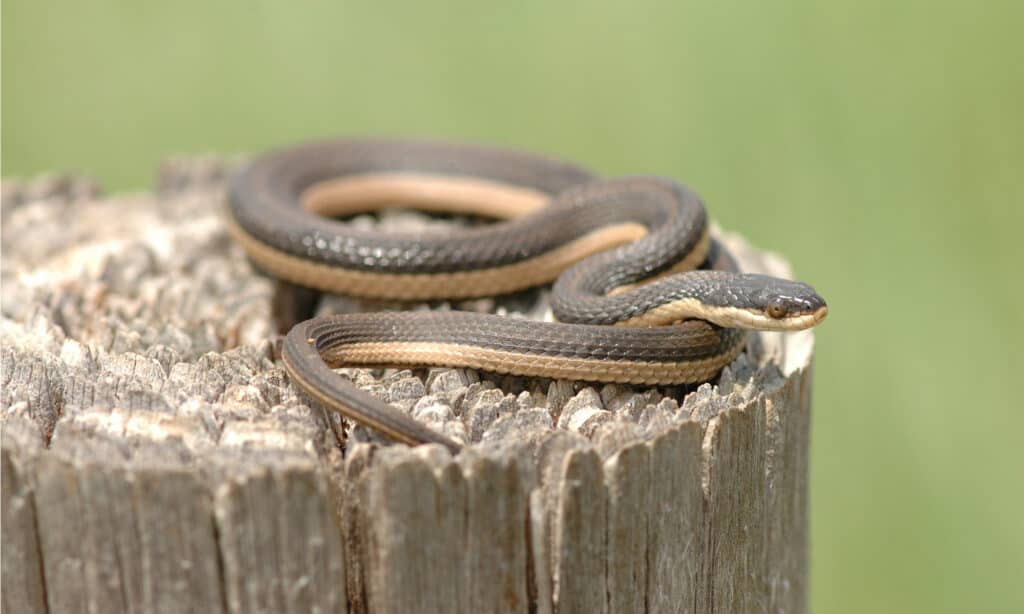
Rusty Dodson/Shutterstock.com
Graham’s crayfish snakes have a dull brown coloration similar to a cottonmouth. The light yellow and tan stripes along their sides are the only distinguishing features you should look out for. They also spend a lot of their time near water.
Discover the “Monster” Snake 5X Bigger than an Anaconda
Every day A-Z Animals sends out some of the most incredible facts in the world from our free newsletter. Want to discover the 10 most beautiful snakes in the world, a “snake island” where you’re never more than 3 feet from danger, or a “monster” snake 5X larger than an anaconda? Then sign up right now and you’ll start receiving our daily newsletter absolutely free.
More from A-Z Animals
.more-snake-card-image { max-height:140px !important; }
#mobileSnakeQuizControls { overflow: hidden; text-overflow: ellipsis; white-space: nowrap; }
@media (min-width: 481px) {
.mobile-top-content {
display: none;
}
}
#mobileTopContentCTACarouselControls { overflow: hidden; text-overflow: ellipsis; white-space: nowrap; }
.mobile-top-content .more { color: #fff; }
.mobile-top-content a { color: #fff; text-decoration: underline; }
.mobile-top-content a:hover { color: #fff; text-decoration: underline; }
@media (max-width: 480px) {
.mobile-top-content {
background-color: #06a10b;
color: #fff;
text-align: center;
/*height: 60px;
padding-top:5px;*/
font-size:80%;
/* display: block; */
margin: 0px -30px;
}
}
Also known as a water moccasin, black mocassin, gaper, and swamp moccasin, the cottonmouth (Agkistrodon piscivorus) is a highly venomous pit viper species native to the southeastern United States. Cottonmouths often spend time near water, so you will likely find them in river floodplains, wetlands, bays, lakes, swamps, and other marshy areas. They are capable swimmers that can swim between barrier islands and the mainland.
Adult cottonmouths deliver a painful and potentially fatal bite when provoked. They usually stand their ground, gape at the intruder, and respond by coiling their bodies and displaying their fangs when threatened.
Adults are 2-6 feet long. Females are smaller than males. Females weigh between 7.09-8.96 oz (201.1-254.1 g), while males weigh around 10.32-20.44 oz (292.5-579.6 g). They vary from light brown to dark brown, with dark spots and speckles on their crossbands. They have bright white mouths and large spade-shaped heads.
button.pulse {
transform: scale(1); animation: pulse 2s infinite;
box-shadow: 0 0 0 0 rgba(11, 247, 25, 1);
}
@keyframes pulse {
0% { transform: scale(0.90); box-shadow: 0 0 0 0 rgba(11, 247, 25, 0.5); }
60% { transform: scale(1); box-shadow: 0 0 0 15px rgba(11, 247, 25, 0); }
100% { transform: scale(0.90); box-shadow: 0 0 0 0 rgba(11, 247, 25, 0); }
}
But what about baby cottonmouth? Baby cottonmouths have striking features that differentiate them from adults. This article will give you insights about baby cottonmouth season and how you can distinguish them from other water snakes.
When Do Baby Cottonmouths Start Appearing?

Kristian Bell/Shutterstock.com
Cottonmouths mate in spring, generally from April to May. During this time, males slither around, waving their tails to attract the females’ attention and lure them away from other male suitors.
The gestation period lasts five months, and females give birth to around 10-20 offspring every 2 to 3 years. Baby cottonmouths are born in late summer. They are typically about 8 inches (20 cm) long and are born brightly colored, which fades off as soon as they start going on their own. They weigh approximately 1.14 oz (32.5 g) at birth.
How to Identify a Baby Cottonmouth

Kristian Bell/Shutterstock.com
Baby cottonmouths are often mistaken for other non-venomous water snakes. They have a distinctive green or yellowish tail. The tail changes from yellow to green hue as they head into adolescence, and eventually black. Black tails are a clear indication that they have reached adulthood.
Unlike the adult’s black color, baby cottonmouths are tan with around 10-25 reddish-brown bands that appear darker. The ridged or keeled scales at the back of these snakes make their bands more prominent. Their skin darkens as they age.
Baby cottonmouths have a light-creamed belly decorated with brown-yellow blotches, giving them a unique appearance. The young cottonmouth has two dark stripes by its nostrils. Their chins appear darker on the head. This is one way you can differentiate them from a baby copperhead snake.
Where Do you Find Baby Cottonmouths?
Like their parents, the young water moccasins enjoy living close to marshes, swamps, and ponds. They can also be found in streams and drainage ditches. You may catch a glimpse of a baby cottonmouth swimming with its head above the water surface. They hibernate during the winter in rotting stamps or burrows made by other animals, including turtles and crayfish.
What Do Baby Cottonmouths Eat?

Mark_Kostich/Shutterstock.com
Their diet comes from the water they inhabit. The young water moccasins mainly eat lizards, fish, frogs, tiny turtles, and small snakes occasionally. They are predominantly carnivores. Baby cottonmouths are typically active early in the morning and late in the evening, especially in the summer.
They hunt prey in water or on land. Baby cottonmouths kill with a venomous bite, then wrap around their prey until it stops moving before swallowing. In turn, they are vulnerable to predation from animals like cats, eagles, raccoons, alligators, and snapping turtles, which is why many baby cottonmouths hardly make it to adulthood.
How Does the Diet of Baby Cottonmouths Impact the Ecosystem?
Baby cottonmouths maintain balance in the food web. Without them, the number of frogs, lizards, fish, and other prey would increase to unnatural levels and destroy the stability of the ecosystem. Similarly, if many baby cottonmouths are killed, eagles, alligators, and other predators that eat the young moccasins will struggle to find food.
Are Baby Cottonmouths Dangerous?
Baby cottonmouths are not more dangerous than adults. Like adults, they only bite when provoked. The young mocassin produces less venom, but its bite is excruciating and dangerous to humans. The poison causes immense swelling and tissue damage. The bite also contains extra bacterial infection since they sometimes feed on carrion.
What Happens When a Baby Cottonmouth Bites You?
Baby cottonmouths’ venom falls under the category of a hemotoxin, which affects the circulatory system by inhibiting blood clotting through the destruction of red blood cells. Humans bitten by the juveniles will feel an immediate burning pain. The wound then swells after a few minutes. Lack of immediate medical attention may lead to permanent tissue and muscle damage. The victim may even require amputation if left untreated.
What Snakes are Most Commonly Mistaken for Baby Cottonmouths?
Many baby cottonmouth look-alikes often get mistakenly killed. Here are some of the species to help you distinguish between the young moccasins and other non-venomous snakes.
1. Hognose Snake

iStock.com/chas53
Like the baby cottonmouths, hognose snakes have dark body colors and faint bands. They also exhibit color variations as they age. Hognose snakes flatten their heads and strike with closed mouths when threatened. As opposed to hognose snakes, the young moccasins attack while theatrically displaying the white interiors of their mouths. Both snakes also live in different habitats. Hognose snakes prefer a drier habitat, while baby cottonmouths live near water.
2. Western Mud Snake

Thesigner_2696/Shutterstock.com
The western mud snake resembles an adult cottonmouth when viewed from the top due to its dark colors. You can only distinguish between the two using the bright red ventral scales that the western mud snake has and that cottonmouths don’t have. Mud snakes are also found near swamps and marshes.
3. Graham’s Crayfish Snake

Rusty Dodson/Shutterstock.com
Graham’s crayfish snakes have a dull brown coloration similar to a cottonmouth. The light yellow and tan stripes along their sides are the only distinguishing features you should look out for. They also spend a lot of their time near water.
Discover the “Monster” Snake 5X Bigger than an Anaconda
Every day A-Z Animals sends out some of the most incredible facts in the world from our free newsletter. Want to discover the 10 most beautiful snakes in the world, a “snake island” where you’re never more than 3 feet from danger, or a “monster” snake 5X larger than an anaconda? Then sign up right now and you’ll start receiving our daily newsletter absolutely free.







